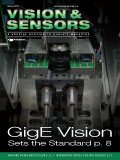
One of many interfaces alongside FireWire, FireWireB, USB2, CameraLink, and now USB3 and CoaXPress, GigE Vision has been growing rapidly and has established itself as one of the interfaces of choice in the machine vision world. What makes this interface so popular with system integrators? What is the future for GigE Vision?

GigE Vision allows the unlimited networking of machine vision cameras, a feature particularly useful for expanding the field of view or facilitating multiple views of the same scene using multiple cameras. GigE cameras are shown here set up as a network. Source: Allied Vision Technologies
High standards
Gigabit Ethernet, or GigE, is a particularly fast version of Ethernet. At 1,000 megabits per second (Mbps), Gigabit Ethernet is much faster than standard Ethernet (10 Mbps) and fast Ethernet (100 Mbps) and is capable of streaming uncompressed image data and providing reliable transmission from a camera to a host computer in real time at speeds that exceed the requirements of most industrial machine vision applications.Similarly to FireWire with DCAM (IIDC), Gigabit Ethernet is regulated by its own standard. The GigE Vision camera control registers are based on a command structure called GenICam that is administered through the European Machine Vision Association (EMVA). The GigE Vision standard, thanks to its common camera control interface, ensures that all GigE Vision compliant cameras are fully compatible with all third-party software and hardware, thus offering value for reducing system integration costs and improving ease of use.

An ultra-compact GigE camera setup is seen inside an automated prescription dispenser. Source: Manchac Technologies LLC
Simplicity and performance
Since the introduction of GigE Vision, system integrators have begun transitioning from analog to digital interfaces due to obsolescence, higher performance and plug-and-play capabilities. GigE Vision is popular with system integrators because it combines many features that are unavailable in other camera interfaces such as high data rate-required for uncompressed video or imaging applications-low-cost cabling, plug-and-play capability and ubiquitous computer interface hardware that negates the need for special interface cards or frame grabbers in order to operate a machine vision camera.
Gigabit Ethernet provides a high performance camera interface that is able to convey control and image data over long cable lengths by far exceeding those of Camera Link, FireWire or USB. The back view of a single-port GigE camera is shown here. Source: Allied Vision Technologies
GigE Vision in practice
The range of GigE Vision-compliant cameras available to system integrators-low to high resolution, fast frame rates, single-board, periscope-type cameras, compact to ultra-compact housings-make the GigE Vision standard ideal for almost every machine vision application from industrial inspection to traffic imaging, OEM applications, intelligent traffic systems (ITS), public security imaging and aerial photography.Gigabit Ethernet provides a high performance camera interface that is able to convey control and image data over long cable lengths by far exceeding those of Camera Link, FireWire or USB. Cable lengths of up to 100 meters long using low-cost CAT5e or CAT6 cabling are possible, or even longer using switches or fiber optics.
Thanks to its compatibility with standard Ethernet hardware, GigE Vision allows the unlimited networking of machine vision cameras, a feature particularly useful for expanding the field of view or facilitating multiple views of the same scene using multiple cameras. In addition, GigE’s 1,000 Mbps bandwidth allows users to share a single Ethernet port between multiple cameras using a switch, minimizing the integration effort required while being able to support more cameras at higher resolutions and frame rates than competing digital interfaces.
Along with many other new features introduced by GigE Vision, multicasting provides a useful new option. This mechanism facilitates simultaneous image data transfer to multiple computers connected to the camera network. This is particularly useful for distributing the image processing load across several computers, allowing one PC to be responsible for image display and overlay while another PC is focused on gaging, defect detection, image logging or character recognition.

Cameras that offer dual ports and support LAG are able to provide a sustained data rate of 2,000 Mbps. This back view of a dual-port GigE camera features LAG technology. Source: Allied Vision Technologies
GigE Vision's Future
The machine vision market has recently seen the introduction of new interfaces such as USB3 and CoaXPress. To compete with these connectivity options, GigE Vision camera vendors are developing unique solutions for facilitating power over the interface and expanding bandwidth.Continuing its reliance on standard off-the-shelf hardware, LAG-based GigE cameras maintain plug and play capabilities and continue adding value to the digital interface machine vision market.
The future looks bright for GigE. New standards have developed, but the multiple features and benefits of GigE mean it will be around for a long time to come. V&S
